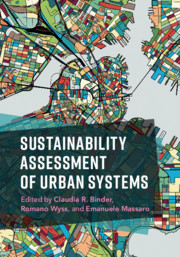Book contents
- Sustainability Assessment of Urban Systems
- Sustainability Assessment of Urban Systems
- Copyright page
- Contents
- Preface
- Acknowledgments
- Contributors
- General Introduction
- Part I Theoretical Background
- 1 Sustainability Assessment: Introduction and Framework
- 2 Systems Science and Sustainability Assessment
- 3 How Values Play into Sustainability Assessments: Challenges and a Possible Way Forward
- 4 The Politics of Participatory Sustainability Assessments: An Analysis of Power
- 5 A Concept for Sustainability Transition Assessment (STA): A Dynamic Systems Perspective Informed by Resilience Thinking
- Part II Integrative Approaches for Sustainability Assessment
- Part III Perspectives on Urban Sustainability
- Part IV Focal Points of Urban Sustainability
- Index
- References
2 - Systems Science and Sustainability Assessment
from Part I - Theoretical Background
Published online by Cambridge University Press: 27 March 2020
- Sustainability Assessment of Urban Systems
- Sustainability Assessment of Urban Systems
- Copyright page
- Contents
- Preface
- Acknowledgments
- Contributors
- General Introduction
- Part I Theoretical Background
- 1 Sustainability Assessment: Introduction and Framework
- 2 Systems Science and Sustainability Assessment
- 3 How Values Play into Sustainability Assessments: Challenges and a Possible Way Forward
- 4 The Politics of Participatory Sustainability Assessments: An Analysis of Power
- 5 A Concept for Sustainability Transition Assessment (STA): A Dynamic Systems Perspective Informed by Resilience Thinking
- Part II Integrative Approaches for Sustainability Assessment
- Part III Perspectives on Urban Sustainability
- Part IV Focal Points of Urban Sustainability
- Index
- References
Summary
This chapter provides an insight into the role of systems science for sustainability assessment. In the first part, we present seven axioms that have been derived from system-theoretical perspectives and show their relevance for sustainability assessment. Following these axioms, we propose a way to structure and analyse systems following four system characteristics: (1) system boundary and interactions with the external environment; (2) purpose, goals, and associated decision-making drivers and criteria for the system; (3) system structure (subsystems, elements, and their interactions), dynamics, and emerging behaviour; and (4) system information, outcomes monitoring, and learning. These four characteristics were applied to study, first, the historical development of the energy system analysis and, second, an Australian urban systems-transformation initiative. The systems-analysis framework presented provides a good basis for putting the elements of a system analysis into their broader context, and designing purposeful interventions. Especially for more transformational change, the alignment of stakeholder values, institutional arrangements, and available knowledge become key leverage points.
Keywords
- Type
- Chapter
- Information
- Sustainability Assessment of Urban Systems , pp. 30 - 64Publisher: Cambridge University PressPrint publication year: 2020

